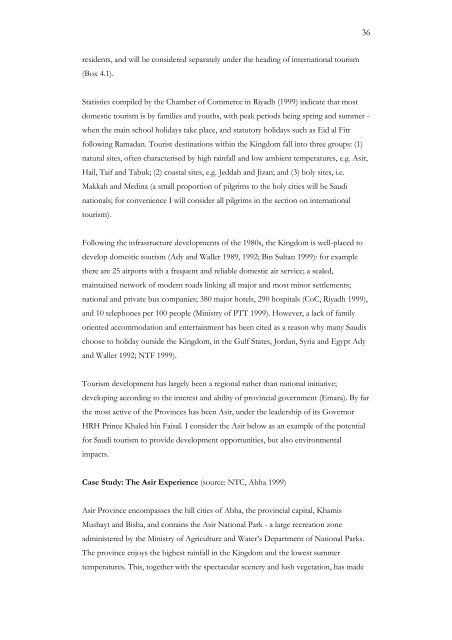The Unfenced Desert Towards a strategy for eco ... - Nwrc.gov.sa
The Unfenced Desert Towards a strategy for eco ... - Nwrc.gov.sa
The Unfenced Desert Towards a strategy for eco ... - Nwrc.gov.sa
Create successful ePaper yourself
Turn your PDF publications into a flip-book with our unique Google optimized e-Paper software.
esidents, and will be considered separately under the heading of international tourism<br />
(Box 4.1).<br />
Statistics compiled by the Chamber of Commerce in Riyadh (1999) indicate that most<br />
domestic tourism is by families and youths, with peak periods being spring and summer -<br />
when the main school holidays take place, and statutory holidays such as Eid al Fitr<br />
following Ramadan. Tourist destinations within the Kingdom fall into three groups: (1)<br />
natural sites, often characterised by high rainfall and low ambient temperatures, e.g. Asir,<br />
Hail, Taif and Tabuk; (2) coastal sites, e.g. Jeddah and Jizan; and (3) holy sites, i.e.<br />
Makkah and Medina (a small proportion of pilgrims to the holy cities will be Saudi<br />
nationals; <strong>for</strong> convenience I will consider all pilgrims in the section on international<br />
tourism).<br />
Following the infrastructure developments of the 1980s, the Kingdom is well-placed to<br />
develop domestic tourism (Ady and Waller 1989, 1992; Bin Sultan 1999): <strong>for</strong> example<br />
there are 25 airports with a frequent and reliable domestic air service; a sealed,<br />
maintained network of modern roads linking all major and most minor settlements;<br />
national and private bus companies; 380 major hotels, 290 hospitals (CoC, Riyadh 1999),<br />
and 10 telephones per 100 people (Ministry of PTT 1999). However, a lack of family<br />
oriented accommodation and entertainment has been cited as a reason why many Saudis<br />
choose to holiday outside the Kingdom, in the Gulf States, Jordan, Syria and Egypt Ady<br />
and Waller 1992; NTF 1999).<br />
Tourism development has largely been a regional rather than national initiative;<br />
developing according to the interest and ability of provincial <strong>gov</strong>ernment (Emara). By far<br />
the most active of the Provinces has been Asir, under the leadership of its Governor<br />
HRH Prince Khaled bin Fai<strong>sa</strong>l. I consider the Asir below as an example of the potential<br />
<strong>for</strong> Saudi tourism to provide development opportunities, but also environmental<br />
impacts.<br />
Case Study: <strong>The</strong> Asir Experience (source: NTC, Abha 1999)<br />
Asir Province encompasses the hill cities of Abha, the provincial capital, Khamis<br />
Mushayt and Bisha, and contains the Asir National Park - a large recreation zone<br />
administered by the Ministry of Agriculture and Water’s Department of National Parks.<br />
<strong>The</strong> province enjoys the highest rainfall in the Kingdom and the lowest summer<br />
temperatures. This, together with the spectacular scenery and lush vegetation, has made<br />
36

















